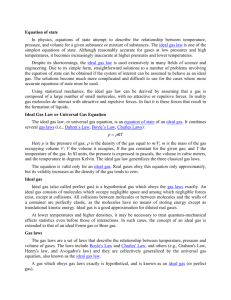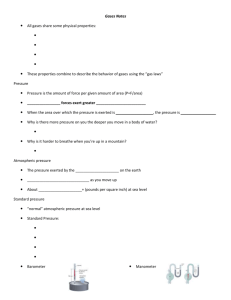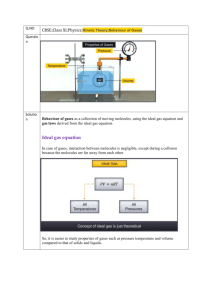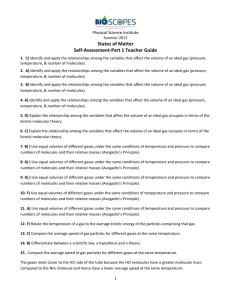Notes
advertisement
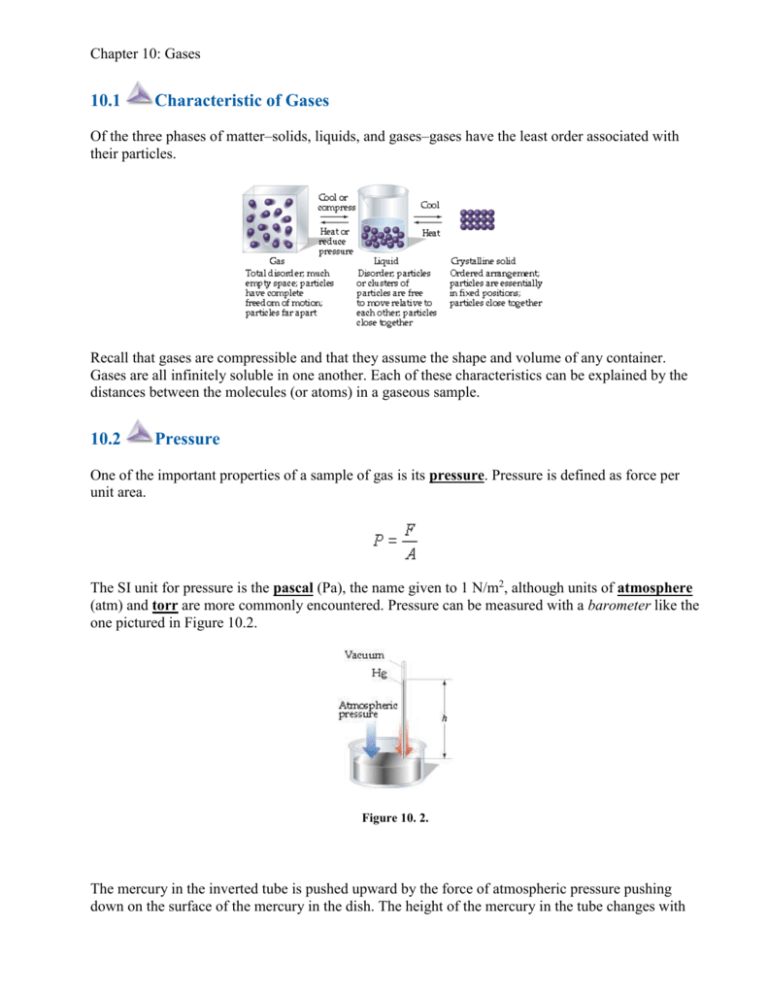
Chapter 10: Gases 10.1 Characteristic of Gases Of the three phases of matter–solids, liquids, and gases–gases have the least order associated with their particles. Recall that gases are compressible and that they assume the shape and volume of any container. Gases are all infinitely soluble in one another. Each of these characteristics can be explained by the distances between the molecules (or atoms) in a gaseous sample. 10.2 Pressure One of the important properties of a sample of gas is its pressure. Pressure is defined as force per unit area. The SI unit for pressure is the pascal (Pa), the name given to 1 N/m2, although units of atmosphere (atm) and torr are more commonly encountered. Pressure can be measured with a barometer like the one pictured in Figure 10.2. Figure 10. 2. The mercury in the inverted tube is pushed upward by the force of atmospheric pressure pushing down on the surface of the mercury in the dish. The height of the mercury in the tube changes with changing atmospheric pressure. Under conditions of standard atmospheric pressure, the height of the mercury in the tube is 760 mm. (1 atm = 760 mm Hg = 760 torr = 1.01325 105 Pa) 10.3 The Gas Laws Four variables must be specified to define the physical condition of a gas: temperature, T; pressure, P; volume, V; and the amount of the gas, usually expressed in moles, n. The equations that express the relationships among these variables are known as the gas laws. Boyle's law states that at constant temperature the volume of a fixed amount of gas is inversely proportional to its pressure. P x V = Constant The value of the constant depends on the other two variables—temperature and moles. Charles's law states that at constant pressure the volume of a fixed amount of gas is directly proportional to its absolute temperature. V/T = Constant Again, the value of the constant depends on the other two variables: pressure and moles. Note that the constant in the equation for Charles's law is not the same constant as the one in Boyle's law. Avogadro's law states that at constant pressure and temperature, the volume of a gas depends on the number of moles. V/n = Constant Again, the constant depends on the values of pressure and temperature, and the constant in Avogadro's law is different from either of the constants in the other gas laws. Figure 10.11. Gay-Lussac's experimental observation of combining volumes shown together with Avogadro's explanation of this phenomenon. Related to Avogadro's law, Avogadro's hypothesis says that equal volumes of gas at the same temperature and pressure contain equal numbers of molecules. 10.4 The Ideal-Gas Equation The equations for Boyle's law, Charles's law, and Avogadro's law can all be combined to give a more general equation. PV = nRT We call the constant in this general expression R, the gas constant. R is often expressed as 0.08206 L-atm/mol-K; it can, however, be expressed in other units, depending on the units used for the variables V, T, and P. An ideal gas being a hypothetical gas, its behavior is described by this equation. We start by using the ideal-gas equation to determine the molar volume (volume of 1 mol) of an ideal gas under conditions of standard temperature and pressure (STP). The standard pressure is, as always, 1 atm. The standard temperature is 0°C. Note that this standard temperature is different from the standard temperature given in eChapter 5 for thermodynamics (25°C). Rearranging the ideal-gas equation to solve for V we get Entering the values for n, R, T, and P, we get the volume of 1.000 mol of any ideal gas at 0°C and 1.000 atm. Although real gases do not behave ideally, under many conditions the difference between their behavior and the behavior predicted by the ideal-gas equation is small enough to ignore. This allows us to apply the ideal-gas equation to most problems involving real gases. Returning to Boyle's and Charles's laws, we see that each can be considered a version of the idealgas equation in which two of the four variables are fixed. This restatement of Boyle's law allows us to set the product of V and P for any two conditions (provided n and T are constant) equal to each other. If we know that a particular sample of gas at constant temperature occupies 2.5 L at 1.0 atm, we can predict the volume it will occupy at 5.0 atm. This restatement of Charles's law lets us set the quotient of any two V and T values (at constant n and P) equal to each other. We can use this relationship to solve gas problems in which only volume and temperature change. 10.5 Further Applications of the Ideal-Gas Equation The ideal-gas equation can be manipulated to solve a variety of different types of problems. In order to determine the density of a gas, we rearrange the equation to Density of a gas is generally expressed in g/L. Multiplication of the left and right sides of the equation by the molar mass ( ) of the gas gives This allows us to determine the density of a gas when we know the molar mass, or vice versa. The ideal-gas equation frequently is used to interconvert between volumes and molar amounts in chemical equations. What volume of carbon dioxide gas is produced at STP by the decomposition of 0.150 g CaCO3 via the equation: Begin by converting the mass of calcium carbonate to moles. The stoichiometry of the reaction dictates that the number of moles CaCO3 decomposed equals the number of moles CO2 produced. Use the ideal-gas equation to convert moles of CO2 to a volume. 10.6 Gas Mixtures and Partial Pressures Dalton's law of partial pressures states that the total pressure (Pt) exerted by a mixture of gases is the sum of the pressures that would be exerted by each individual gas were it the only gas present. where P1 is the partial pressure of gas 1 (the pressure exerted by gas 1), P2 is the partial pressure of gas 2, and so on. Each component of a gaseous mixture behaves independently of the other components, and a separate ideal-gas equation can be written for each component. or for the sum of all components where nt is the total number of moles in the mixture. The total pressure exerted by a mixture of 3.00 g CO2 and 1.53 g He in a 1.25-L vessel at 0° C is: and The ratio of partial pressure of a particular component of a gaseous mixture to the total pressure exerted by the gas mixture is the mole fraction. Mole fraction, denoted X, is a measure of a gas's concentration in a mixture. It can also be calculated as the ratio of moles of the component to the total number of moles in the mixture. Knowing the mole fraction of a component and the total pressure of a mixture, we can calculate the partial pressure of the component. 10.7 Kinetic-Molecular Theory Kinetic-molecular theory is a way to explain why gases obey the gas laws, and it is summarized by the following statements. 1. Gases consist of large numbers of molecules that are in continuous, random motion. (The word molecule is used here to designate the smallest particle of any gas; some gases, such as noble gases, consist of individual atoms.) 2. The volume of all the molecules of the gas is negligible compared to the total volume in which the gas is contained. 3. Attractive and repulsive forces between gas molecules are negligible. 4. Energy can be transferred between molecules during collisions, but the average kinetic energy of the molecules does not change with time, as long as the temperature of the gas remains constant. In other words, the collisions are perfectly elastic. 5. The average kinetic energy of the molecules is proportional to the absolute temperature. At any given temperature the molecules of all gases have the same kinetic energy. Kinetic-molecular theory can be used to explain observations of the behavior of gases. 1. Effect of a volume increase at constant temperature. The fact that temperature remains constant means that the average kinetic energy of the gas molecules remains unchanged. This in turn means that the rms speed of the molecules, u, is unchanged. However, if the volume is increased, the molecules must move a longer distance between collisions. Consequently, there are fewer collisions per unit time with the container walls, and the pressure decreases. Thus, the model accounts in a simple way for Boyle's law. 2. Effect of a temperature increase at constant volume. An increase in temperature means an increase in the average kinetic energy of the molecules, and thus an increase in u. If there is no change in volume, there will be more collisions with the walls per unit time. Furthermore, the change in momentum in each collision increases (the molecules strike the walls harder). Hence, the model explains the observed pressure increase. 10.8 Molecular Effusion and Diffusion Diffusion is the mixing of one substance with another. Effusion is the escape of a gas from a container through a small opening. A consequence of the fact that molecular speed at a particular temperature depends on molecular mass is that lighter molecules undergo diffusion and effusion at faster rates than do heavier molecules. This is summarized by Graham's law: where r1 and r2 are the rates of effusion of two different gases under the same conditions. This explains why balloons filled with helium deflate more rapidly than those filled with air. The helium atoms, being lighter, escape through the tiny openings in the porous rubber faster than the heavier nitrogen and oxygen molecules that make up air. Diffusion is related to effusion, and Graham's law can be used to approximate relative rates of diffusion. However, diffusion is complicated by collisions between molecules. Collisions make molecules change direction constantly, thereby impeding their linear progress. The mean free path is the average distance traveled by a molecule between collisions. The mean free path of molecules at atmospheric pressure is about 60 nm. 10.9 Real Gases: Deviations from Ideal-Behavior Although the differences in behavior between real and ideal gases are usually small, it is worthwhile to consider the small differences. For one mole of an ideal gas at all values of P. Figure 10.22 shows the graph of for several gases, all at around 300 K. for one mole of gas as a function of pressure Figure 10. 22. Note how the deviation from ideal behavior is significant, especially at very high pressures. Low pressure is one of the conditions under which real gases tend to behave ideally. Figure 10.23 shows the graph of for nitrogen gas at three different temperatures. This figure illustrates the other condition, high temperature, under which real gases tend to behave ideally. Figure 10. 23. Deviations from ideal behavior result from the error in assuming that (1) gas molecules occupy no volume, and (2) gas molecules exhibit no intermolecular forces. At very low pressures and very high temperatures, these assumptions are reasonably valid. Calculations for problems involving real gases are done with a modified gas equation known as the van der Waals equation. P = nRT/(V – nb) – (n2a)/V2 The terms a and b are the van der Waals constants that are unique to a particular gas. The values of van der Waals constants for a selection of gases are given in Table 10.3.


